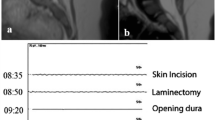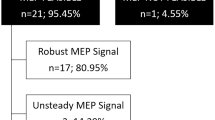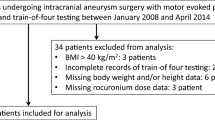Abstract
Intraoperative neuromonitoring has become an increasingly commonly applied practice during surgical operations for preventing formation of neurological damage. Although it has been used on adults for a long time, the benefits and techniques of applying it in small children are not clear. We applied two different anesthesia protocols during meningomyelocele repair alongside motor-evoked potentials in a newborn and a small infant. We discussed our anesthesia management method and the effects of anesthesia on intraoperative neuromonitoring in our two very young cases in only one of which we obtained significant records.

Similar content being viewed by others
References
Ghodke S, Hiremath RN, Basundra S (2017) Meningomyelocele repair in a premature newborn with hydrocephalus: anaesthetic confronts and management. JKIMSU 6:129–133
Deiner S (2010) Highlights of anesthetic considerations for intraoperative neuromonitoring. Semin Cardiothorac Vasc Anesth 14:51–53
Busso VO, McAuliffe JJ (2014) Intraoperative neurophysiological monitoring in pediatric neurosurgery. Paediatr Anaesth 24:690–697
Drake J, Zeller R, Kulkarni AV, Strantzas S, Holmes L (2010) Intraoperative neurophysiological monitoring during complex spinal deformity cases in pediatric patients: methodology, utility, prognostication, and outcome. Childs Nerv Syst 26:523–544
Patel AJ, Agadi S, Thomas JG, Schmidt RJ, Hwang SW, Fulkerson DH, Glover CD, Jea A (2013) Neurophysiologic intraoperative monitoring in children with Down syndrome. Childs Nerv Syst 29:281–287
Kim SM, Kim SH, Seo DW, Lee KW (2013) Intraoperative neurophysiologic monitoring: basic principles and recent update. J Korean Med Sci 28:1261–1269
Solan T (2010) Anesthesia and intraoperative neurophysiological monitoring in children. Childs Nerv Syst 26:227–235
Sloan TB, Toleikis JR, Toleikis SC, Koht A (2015) Intraoperative neurophysiological monitoring during spine surgery with total intravenous anesthesia or balanced anesthesia with 3% desflurane. J Clin Monit Comput 29:77–85
Gaynor J, Ansermino JM (2016) Paediatric total intravenous anaesthesia. BJA Education 16(11):369–373
Erb TO, Ryhult SE, Duitmann E, Hasler C, Luetschg J, Frei FJ (2005) Improvement of motor evoked potentials by ketamine and spatial facilitation during spinal surgery in a young child. Anesth Analg 100:1634–1636
Zaarour C, Engelhardt T, Strantzas S, Pehora C, Lewis S, Crawford MW (2007) Effect of low-dose ketamine on voltage requirement for transcranial electrical motor evoked potentials. Spine 32:627–630
Sala F, Squintani G, Tramontano V, Arcaro C, Faccioli F, Mazza C (2013) Intraoperative neurophysiology in tethered cord surgery:techniques and results. Childs Nerv Syst 29:1611–1624
Soghomonyan S, Moran KR, Sandhu GS, Bergese SD (2014) Anesthesia and evoked responses in neurosurgery. Front Pharmacol 5:1–2
Lieberman JA, Lyon R, Feiner J, Diab M, Gregory GA (2006) The effect of age on motor evoked potentials in children under propofol/isoflurane anesthesia. Anesth Analg 103:316–321
Aydınlar EI, Dikmen PY, Kocak M, Baykan N, Seymen N, Ozek MM (2019) Intraoperative neuromonitoring of motor evoked potentials in infants undergoing surgery of the spine and spinal cord. J Clin Neurophysiol 36:60–65
Sala F, Manganotti P, Grossauer S, Tramontanto V, Mazza C, Gerosa M (2010) Intraoperative neurophysiology of the motor system in children: a tailored approach. Childs Nerv Syst 26:473–490
Eyre JA, Taylor JP, Villagra F, Smith M, Miller S (2001) Evidence of activity dependent withdrawal of corticospinal projections during human development. Neurology 57:1543–1554
Author information
Authors and Affiliations
Corresponding author
Ethics declarations
Conflict of interest
The authors declare that they have no conflict of interest.
Additional information
Publisher’s note
Springer Nature remains neutral with regard to jurisdictional claims in published maps and institutional affiliations.
Rights and permissions
About this article
Cite this article
Gisi, G., Boran, O.F. Anesthesia management during meningomyelocele repair alongside motor-evoked potentials in a newborn and a small infant. Childs Nerv Syst 36, 3053–3057 (2020). https://doi.org/10.1007/s00381-020-04579-6
Received:
Accepted:
Published:
Issue Date:
DOI: https://doi.org/10.1007/s00381-020-04579-6




